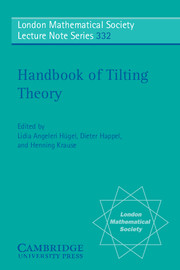Book contents
- Frontmatter
- Contents
- 1 Introduction
- 2 Basic results of classical tilting theory
- 3 Classification of representation-finite algebras and their modules
- 4 A spectral sequence analysis of classical tilting functors
- 5 Derived categories and tilting
- 6 Hereditary categories
- 7 Fourier-Mukai transforms
- 8 Tilting theory and homologically finite subcategories with applications to quasihereditary algebras
- 9 Tilting modules for algebraic groups and finite dimensional algebras
- 10 Combinatorial aspects of the set of tilting modules
- 11 Infinite dimensional tilting modules and cotorsion pairs
- 12 Infinite dimensional tilting modules over finite dimensional algebras
- 13 Cotilting dualities
- 14 Representations of finite groups and tilting
- 15 Morita theory in stable homotopy theory
- Appendix: Some remarks concerning tilting modules and tilted algebras. Origin. Relevance. Future.
9 - Tilting modules for algebraic groups and finite dimensional algebras
Published online by Cambridge University Press: 25 May 2010
- Frontmatter
- Contents
- 1 Introduction
- 2 Basic results of classical tilting theory
- 3 Classification of representation-finite algebras and their modules
- 4 A spectral sequence analysis of classical tilting functors
- 5 Derived categories and tilting
- 6 Hereditary categories
- 7 Fourier-Mukai transforms
- 8 Tilting theory and homologically finite subcategories with applications to quasihereditary algebras
- 9 Tilting modules for algebraic groups and finite dimensional algebras
- 10 Combinatorial aspects of the set of tilting modules
- 11 Infinite dimensional tilting modules and cotorsion pairs
- 12 Infinite dimensional tilting modules over finite dimensional algebras
- 13 Cotilting dualities
- 14 Representations of finite groups and tilting
- 15 Morita theory in stable homotopy theory
- Appendix: Some remarks concerning tilting modules and tilted algebras. Origin. Relevance. Future.
Summary
Introduction
This is a survey article describing some of the ways in which the theory of rational representations of algebraic groups interacts with the representation theory of finite dimension algebras, with particular emphasis on tilting modules.
In its simplest form the connection between the two areas is the following. Let G be a linear algebraic group over an algebraically closed field k. Then the coordinate algebra k[G] is naturally a commutative Hopf algebra, in particular a coalgebra. A coalgebra is the union of its finite dimensional subcoalgebras and, for a finite dimensional coalgebra C, say, there is a natural equivalence of categories between the category of C-comodules and the category of modules for the dual algebra C*. A (rational) G-module is, more or less by definition, a k[G] – comodule. If V is a finite dimensional right comodule, with structure map τ: V → V ⊗ k [G], then the image of τ lies in V ⊗ C, for some finite dimensional subcoalgebra C of k[G] and V is naturally a right C-comodule and hence a left C*-module. Thus the (finite dimensional) representation theory of G is simply the union of the (finite dimensional) representation theories of the finite dimensional algebras C*, as C ranges over finite dimensional subcoalgebras of k[G].
Of course all of this is so far too general to be of any particular use.
- Type
- Chapter
- Information
- Handbook of Tilting Theory , pp. 215 - 258Publisher: Cambridge University PressPrint publication year: 2007
- 17
- Cited by

